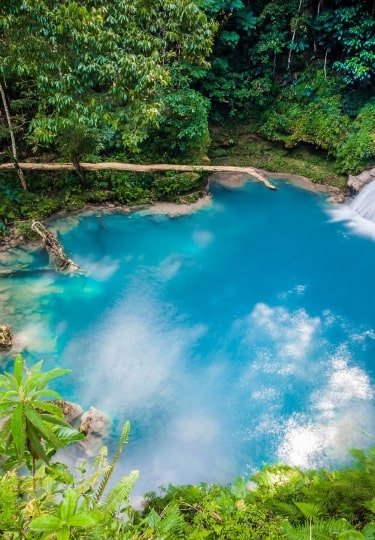What is Jamaica known for? One of the most beautiful islands in the Caribbean, Jamaica is the stuff of tropical dreams: gorgeous beaches, lush rainforests, spectacular waterfalls, lazy rivers for rafting and caves for exploring. The mountains are high enough and cool enough for coffee plantations to flourish, and the West Indian culture is rich in tradition.
Take time to taste the island’s flavors, which range from spicy jerk chicken to rich Blue Mountain coffee and aromatic rums. Explore grand old plantation houses, embrace the lush outdoors, and let the reggae rhythms ease you into pure vacation mode.
Here are 11 things Jamaica is known for.
Dunn’s River Falls
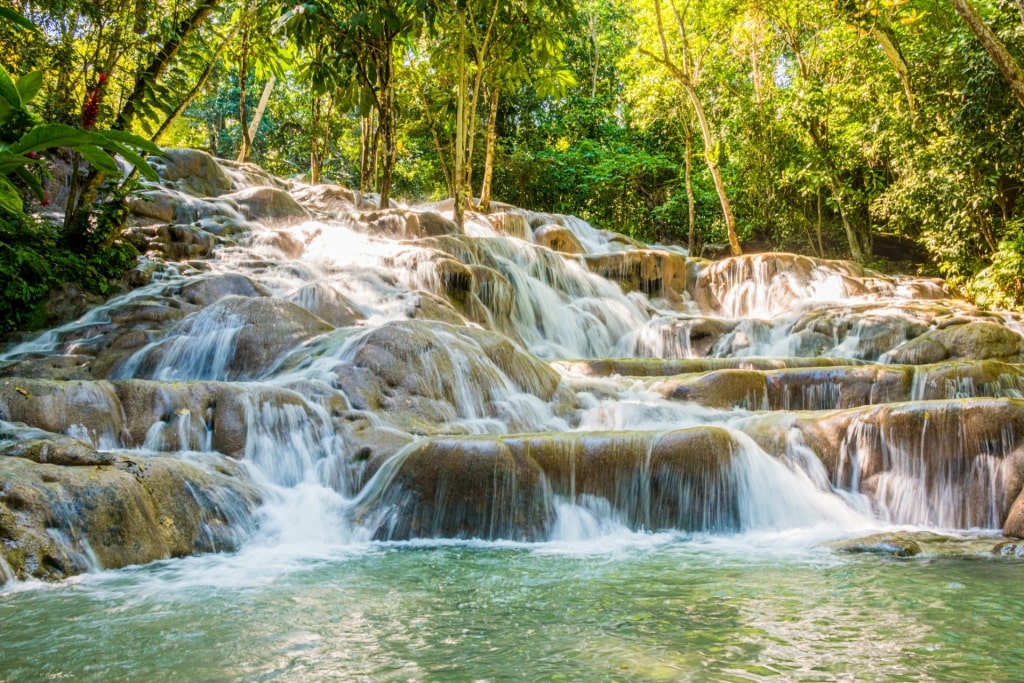
Dunn’s River Falls
Dunn’s River Falls, Ocho Rios, is one of the best-known attractions in Jamaica and is fun to climb. Cascading 600 feet to the sea, the river tumbles over a series of protruding rock ledges that act like natural steps, making it one of the most unique hikes in the Caribbean.
Led by a guide, you join hands with fellow visitors to form a living chain as you scramble over and climb up the slippery, partially submerged rocks. You can rest for a moment in a pool of water en route to the summit to cool off.
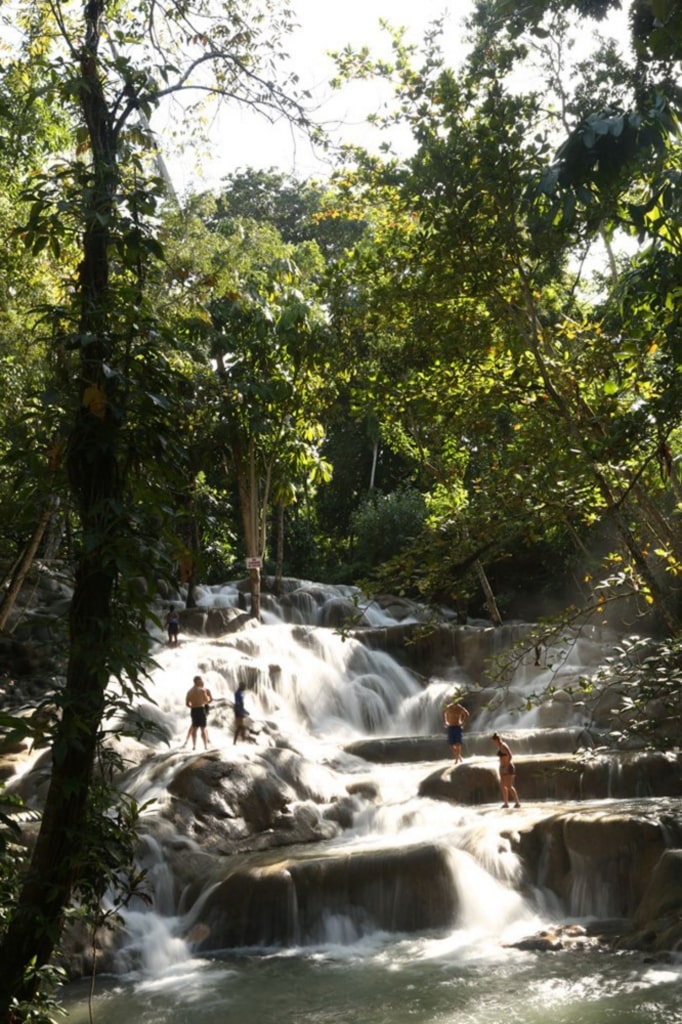
Dunn’s River Falls
If you don’t want to get wet, walk up a path adjacent to the falls. Instead of flip-flops, wear water shoes that won’t slip off your feet from the force of the water.
The waterfall is located in Dunn’s River Falls & Park—one of the best places to visit in Jamaica—a complex that also includes a zipline, beach, and shops.
Reggae Music
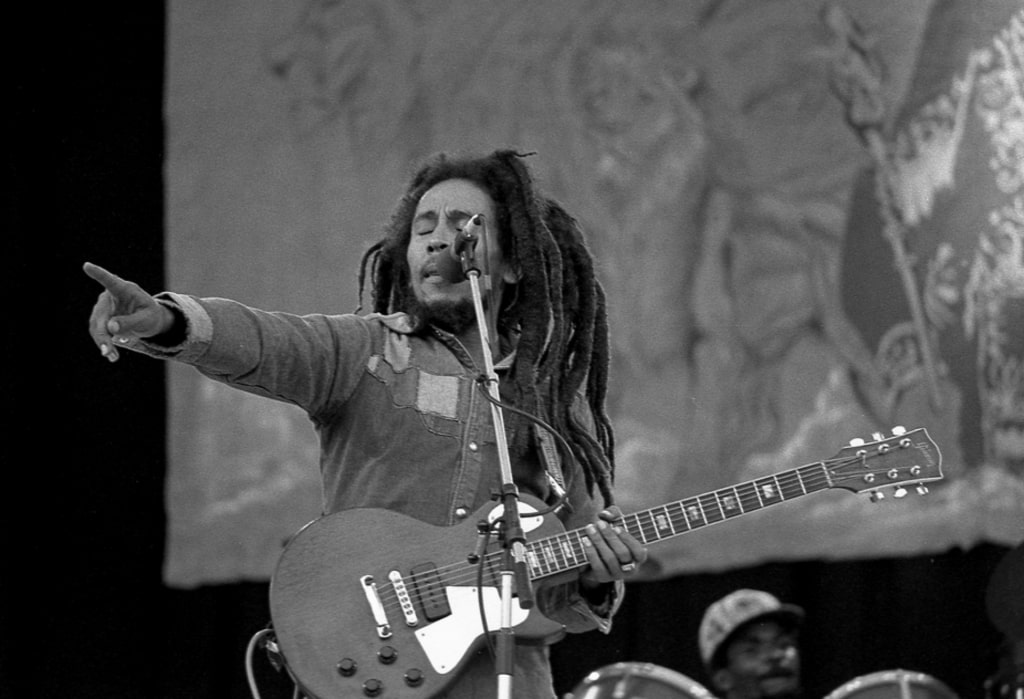
Bob Marley Photo by Eddie Mallin on Wikimedia Commons, licensed under CC BY 2.0
What is Jamaica best known for? Arguably, reggae music. So you’re completely excused if you burst into a spontaneous chorus of Three Little Birds, the Bob Marley and The Wailers classic that epitomizes Caribbean culture.
“Don’t worry about a thing. Cause every little thing gonna be all right,” sounds especially fine on vacation. Marley’s positivity comes across in the song and so do the unique features of reggae.
The roots of reggae, a uniquely Jamaican sound, originated in Kingston in the late 1950s and 1960s when studio musicians fused elements of rhythm and blues, jazz, and mento, which is Jamaican folk music, into the energetic tempo of ska dance music.
In the mid-1960s, ska evolved into a slower, more melodic beat called rocksteady, a short-lived genre that also influenced reggae.
Reggae, popular by the late 1960s and 1970s, slows the beat even more, adds syncopation, a heavy four-beat rhythm, and often focuses on social and economic injustice associated with Rastafarianism and other movements.
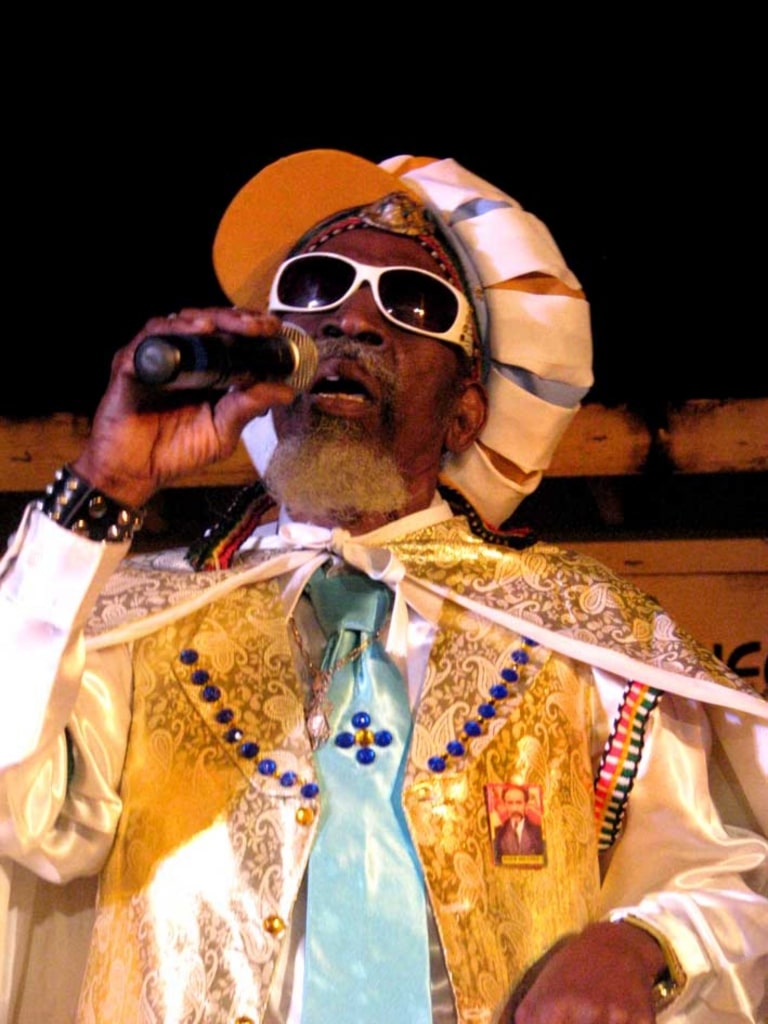
The Wailers Photo by dubdem sound system on Wikimedia Commons, licensed under CC BY 2.0
Several artists popularized reggae beyond Jamaica’s borders, including Jimmy Cliff, whose success with The Harder they Come helped Marley and the Wailers conquer the American market with their 1974 album featuring No Woman, No Cry and other hits. You’ll hear the feel-good beat of reggae anywhere you go in Jamaica.
River Rafting
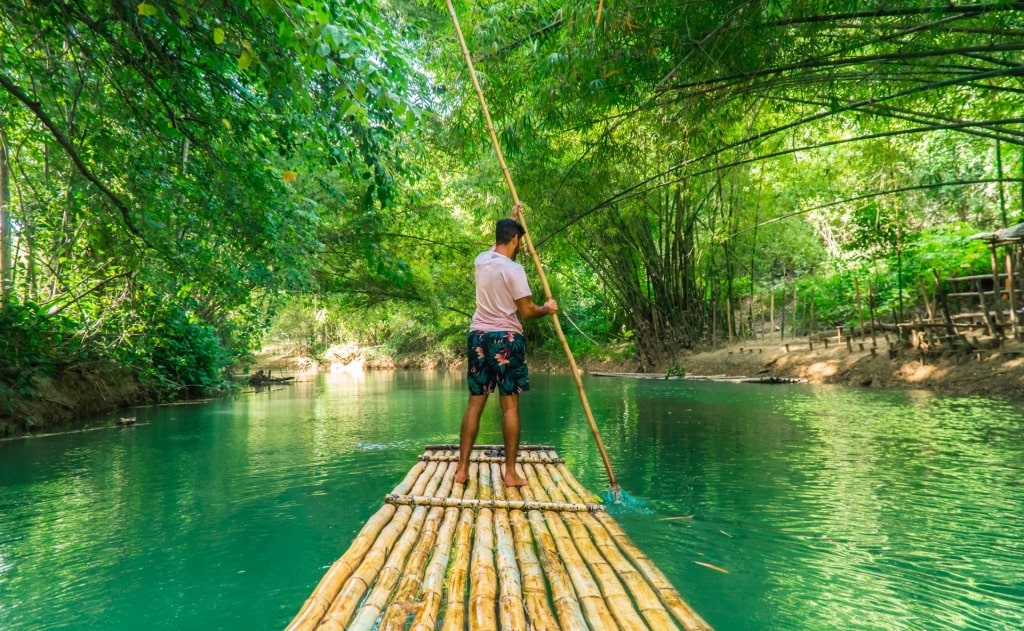
Martha Brae River
Theme parks try to recreate lazy river rides within their lush landscapes, but a raft trip on the Martha Brae is the real thing. You’ll set off high in the hills of Trelawny, then drift along, covering more than three miles of winding river, passing overhanging bamboo and banana trees.
On the relaxing ride, you recline against a bamboo backrest while the boatman poles the 30-foot raft along, sings songs, chats, and recounts stories of local lore.
Jerk Spices
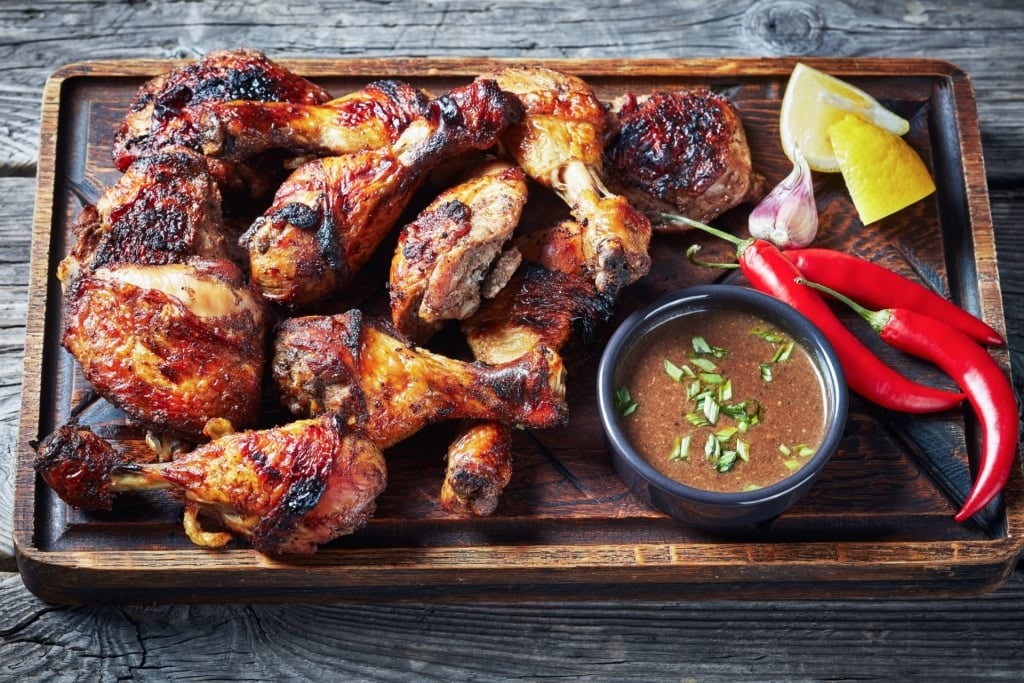
Jerk chicken
Spicy, smoky, and delicious jerk pork, chicken, or beef is one of the things for which Jamaica is known. After marinating or dry rubbing spices on the meat, the cook smokes and grills the protein.
Allspice berries and Scotch bonnet peppers form the basis of the rub to which cooks add their own combination of thyme and scallions, often including ginger, nutmeg, and cinnamon. Traditional jerk food is slow-smoked over pimento wood.
Jerked food has a long tradition in Jamaica, dating back to a melding of culinary techniques used by the native Tainos and the Maroons, formerly enslaved people who fled to freedom in the Jamaican hills when the Spanish abandoned the island for Cuba.
The Maroons, who settled among the Tainos, adapted their food preparation methods. Tainos taught the Maroons how to use local spices to tenderize meat, often wild boar, and to cook in smokeless pits to avoid detection.
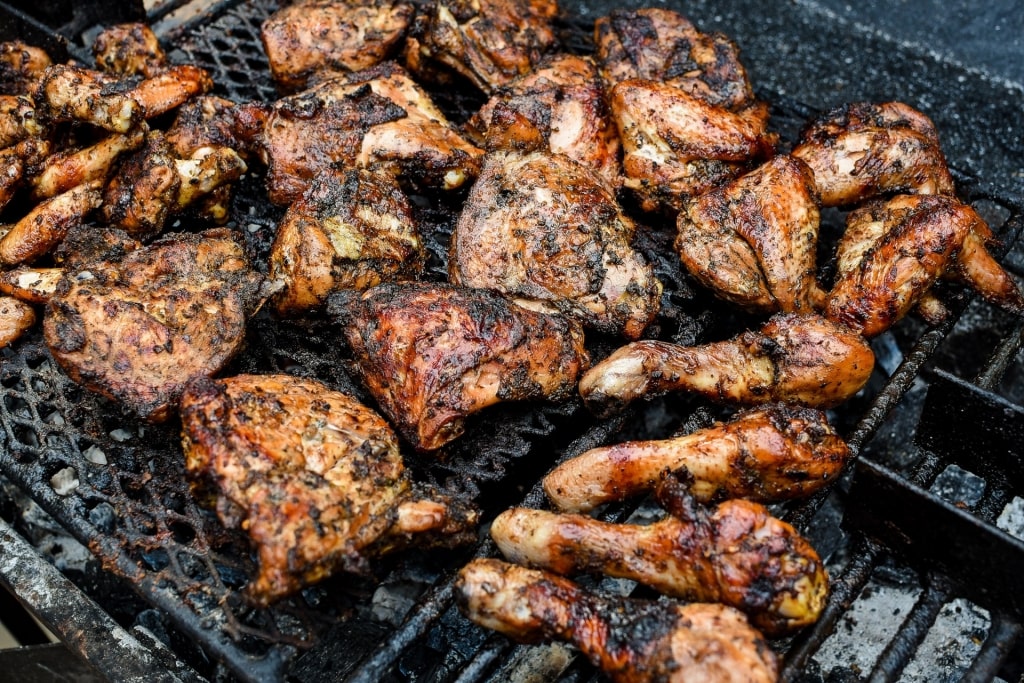
Jerk chicken
One explanation for the term “jerk” is that it came from the practice of “jerking”, or poking holes in the meat to fill it with spices. Another theory is that “jerk” evolved from the Spanish “charqui,” which means dried meat.
Don’t miss the opportunity to taste jerked food when in Jamaica as this is one of the most unmissable things to do in the Caribbean. Try jerk chicken and jerk pork at Walkerswood Jerk Hut on Good Hope Estate, Falmouth, Scotchies in Montego Bay, and Lilliput Jerk Centre, an outdoor bar between Montego Bay and Falmouth.
Read: Best Things to Do in Falmouth
The Blue Hole
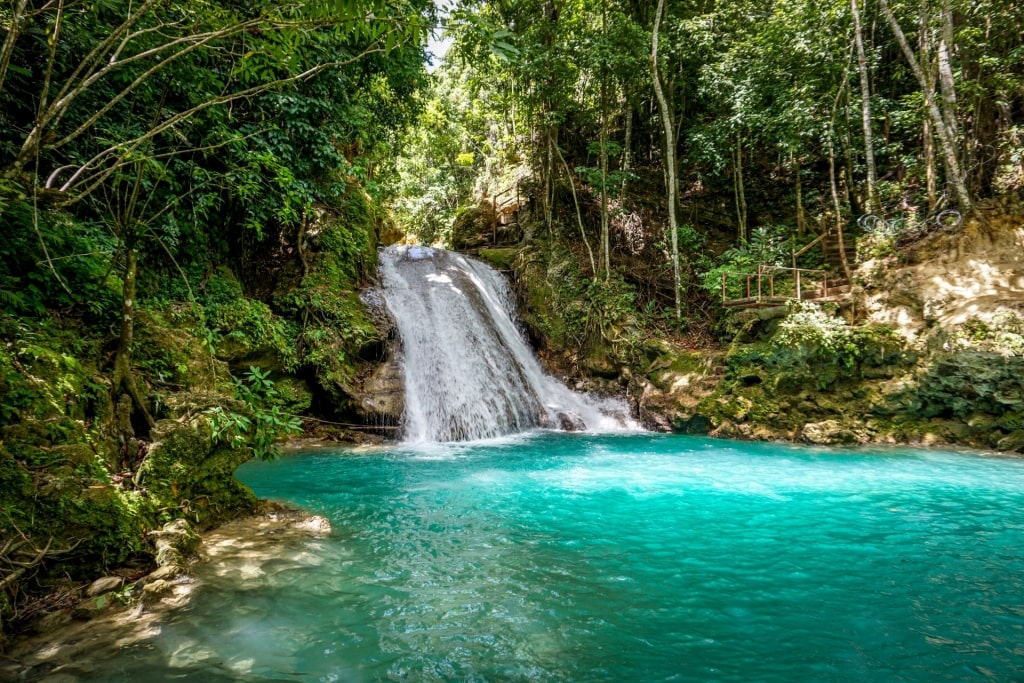
Blue Hole
Even on an island famous for its turquoise seas, the Blue Hole, or Cool Blue Hole, is startling for its deep azure hue and its setting in the hills of Ocho Rios. Lush trees and greenery surround the natural limestone sinkhole, contrasting with the vibrant blue of the water. A sparkling waterfall adds to the Blue Hole’s picture book prettiness.
Feeling feisty? Up the thrills by swinging Tarzan-style from a rope, then jump in, but first ask your guide about safety. You can explore more nearby natural pools, waterfalls, and a small cave.
It’s best to visit early in the morning as afternoons can bring a short, sharp tropical shower.
Read: Best Things to Do in Ocho Rios
Rum
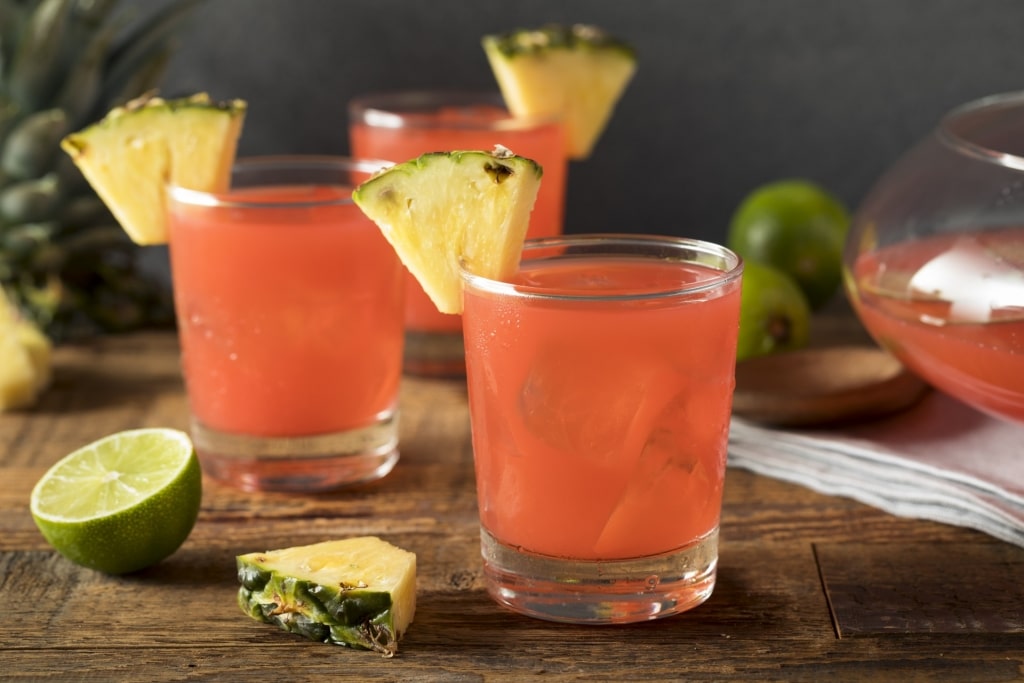
Rum punch
Jamaica is world-famous for its rums. The island’s history—and the history of slavery—is intertwined with the spirit’s production. The warm climate, abundant rainfall, and fertile soil of the Caribbean proved ideal for growing sugarcane.
First introduced by colonists in Barbados in the 1640s and to Jamaica in 1655, sugarcane production grew in the islands.
The production of sugar, and therefore Caribbean rum, required many workers. The colonists kidnapped free men from the west coast of Africa to work the fields as slaves and to process the stalks into raw sugar, often in its liquid form of molasses.
Shipped to New England, an early rum production center, the molasses was fermented, distilled, aged, and blended.
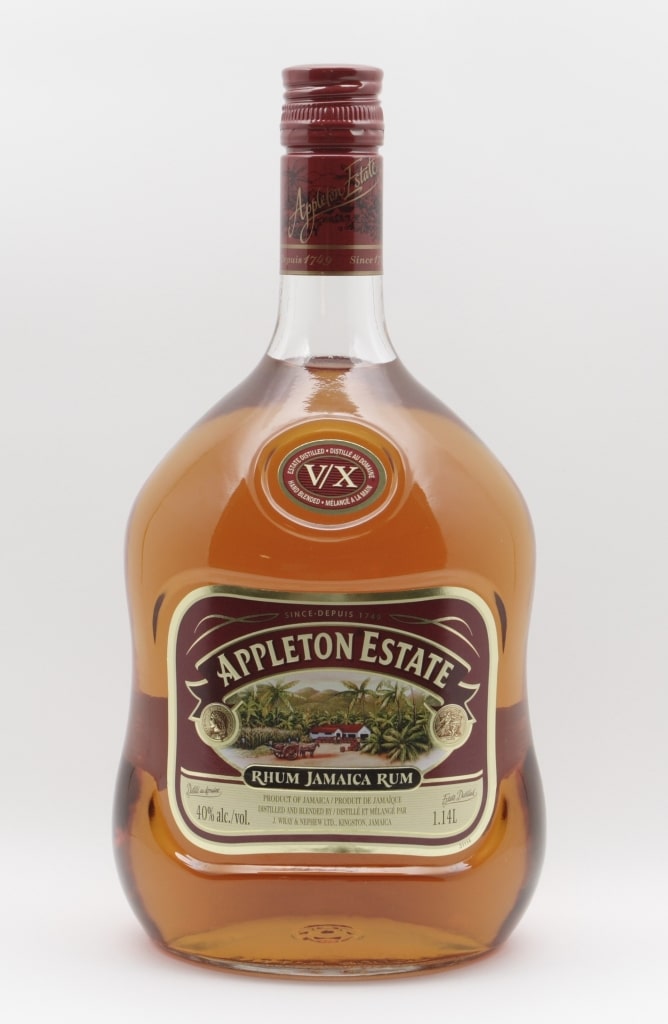
Appleton Estate rum Photo by Nebrot on Wikimedia Commons, licensed under CC BY-SA 3.0
Centuries later, and long after the end of slavery, Jamaica remains famous for its rich and aromatic rums. Appleton Estate rum takes what’s been called a “cane-to-cocktail” approach. The company oversees the onsite cane growing and harvesting, as well as the aging, and blending.
For fermenting, Hampden Estate, east of Montego Bay, uses natural spring water and pot stills. The Hampden Estate Pure Single, the signature rum, is 84 proof. Learn about that rum and Hampden’s others on a tour and tasting at the Hampden Rum distillery.
Green Grotto Caves
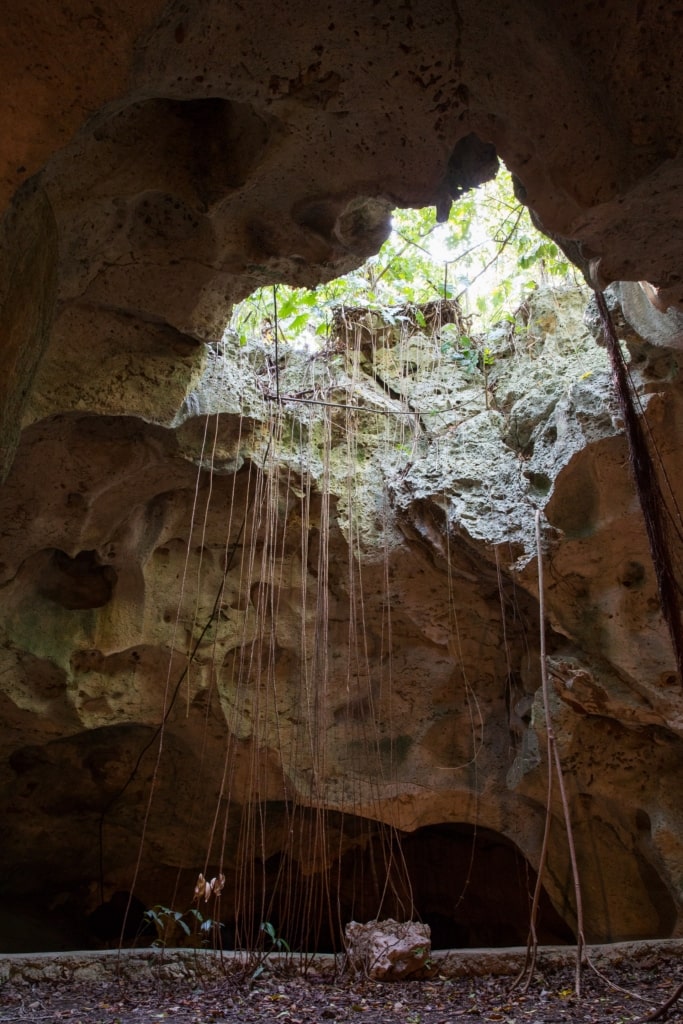
Green Grotto Caves
The Green Grotto Caves are situated between Ocho Rios and Montego Bay, named for the green algae covering the walls. Over centuries, the caves sheltered the Tainos, an Arawak tribe, Spaniards fleeing after the British invaded the Western Caribbean island, runaway slaves, and 20th-century smugglers.
On a guided tour of the mile-long cave system, you see stalactites, stalagmites, bats, and Grotto Lake, an underground body of water. Be sure to wear sneakers or other shoes that grip the sometimes slippery ground.
Great Houses & Sugar Plantations
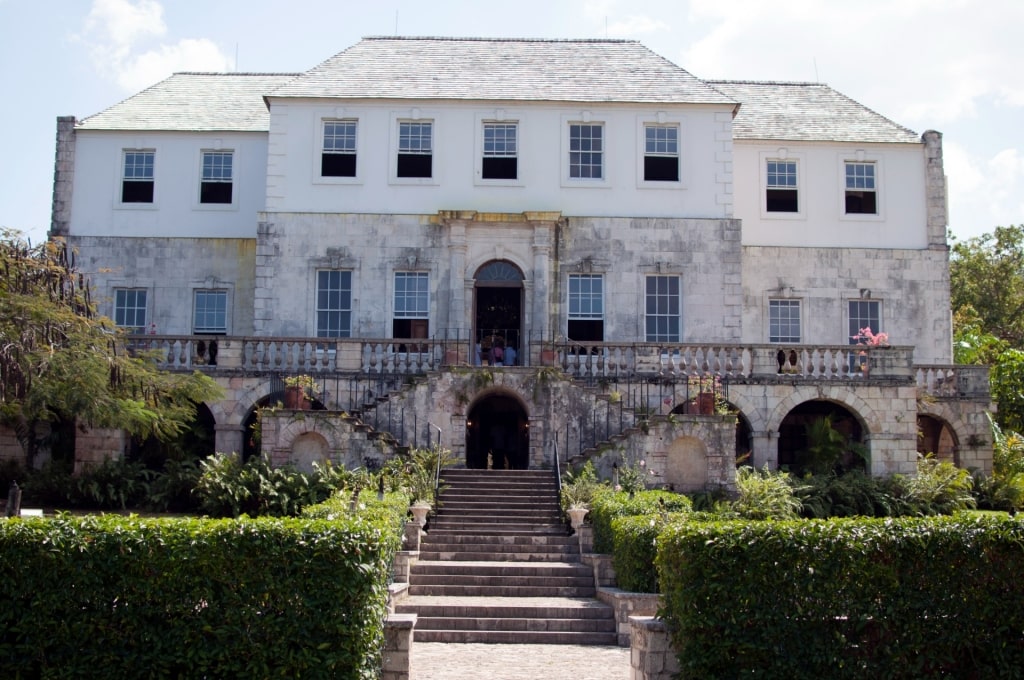
Rose Hall Photo by Don Ramey Logan on Wikimedia Commons, licensed under CC BY-SA 3.0
Rose Hall, built on a lavish scale by English aristocrats, is a prime example of Jamaica’s Great Houses, grand manor houses built during the colonial slave era.
Constructed by John Palmer between 1778 to 1790, Rose Hall, Montego Bay, is one of Jamaica’s best-known Great Houses. At one time, the plantation covered more than 6,500 acres and numbered more than 2,000 slaves. Guides in period attire detail the plantation’s sad history.
Rose Hall is reputed to be haunted, too. Annie Palmer, the villainess of the house’s saga, arrived at the plantation house in 1820 as the wife of John Rose Palmer, the builder’s grandnephew.
Annie, a cruel person, killed off three husbands, beat her slaves mercilessly, and was eventually murdered in her own bed. Her ghost, the White Witch of Rose Hall, the guides say, can sometimes be seen on the halls of the upper floors. Take it all with a grain of salt, but enjoy the scale of the house, the furnishings, and the gardens.
Good Hope Estate, in the hills behind Falmouth, sprawls on 2,000 acres. Established in 1774 as a sugar plantation. Good Hope has two personalities.
Connect to the genteel (for some) country life by touring the Great House, strolling the flower-bedecked grounds, walking through the former slave hospital, now an aviary housing colorful tropical birds, and tasting Appleton Estate Rum crafted in Jamaica.
Connect to Good Hope’s wild side by throwing yourself into eco-adventures. Glide along zip lines, paddle along the river in inflatable tubes, and ride ATVs through the coconut groves and fruit orchards. With either option, allow time to cool off by swimming in the pool.
Local Specialties
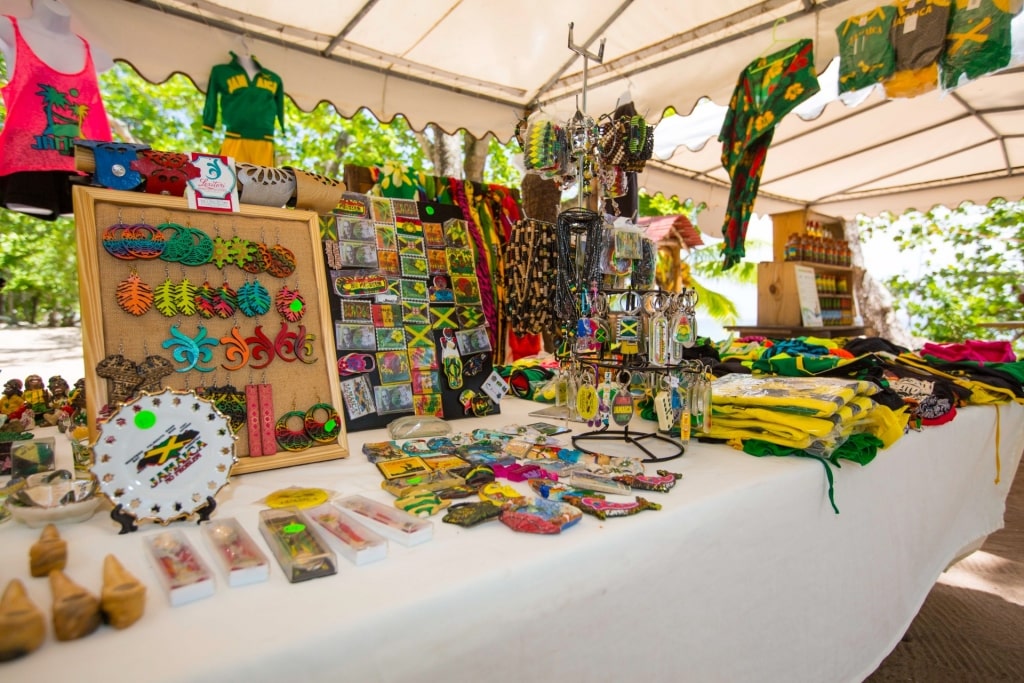
Jamaican souvenirs
Jamaica has plenty of local souvenirs to take home: Blue Mountain coffee, jerk seasonings such as allspice (also called pimento), local rum produced by Appleton Estate and Hampden Estate, and spicy sauces such as the tamarind-based Pickapeppa Sauce and Walkerswood Jerk Sauce, available at Good Hope Estate. You can also find many food items to take home in local grocery stores.
Jamaican artists and craftspeople are brilliantly creative. Peruse wood carvings, paintings, sculptures, pottery, carved furniture, hand-turned wooden bowls, woven straw and banana-leaf items, and cutwork embroidery.
Bargaining is standard practice at straw markets and stalls and with beach vendors. Consider browsing Montego Bay’s Harbour Street Craft Market and the Ocho Rios Craft Market.
Beautiful Beaches
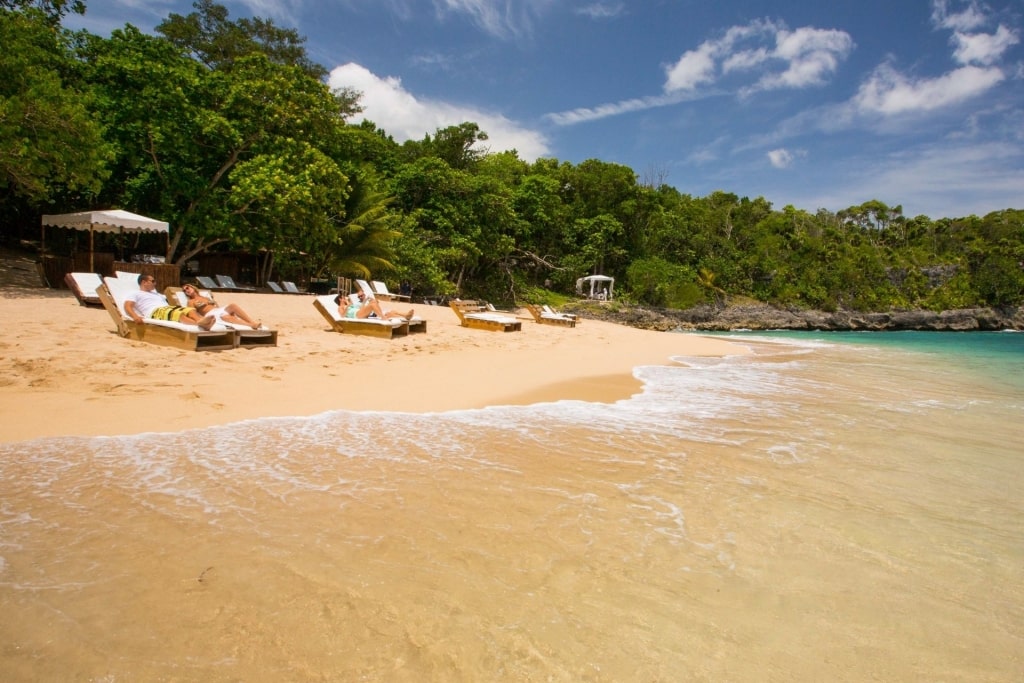
Bamboo Beach Club
Jamaica is known for its soft white sands and calm turquoise waters. A beach club makes it easy to enjoy a shore day by providing all the necessities—chaise lounges, food, shade, drinks, bathrooms, and water toys.
Blue Waters Beach Club, Falmouth, and Bamboo Beach Club, Trelawny, get you into the feel-good rhythms of Jamaica with live reggae music and staff who lead you in line dancing and drumming.
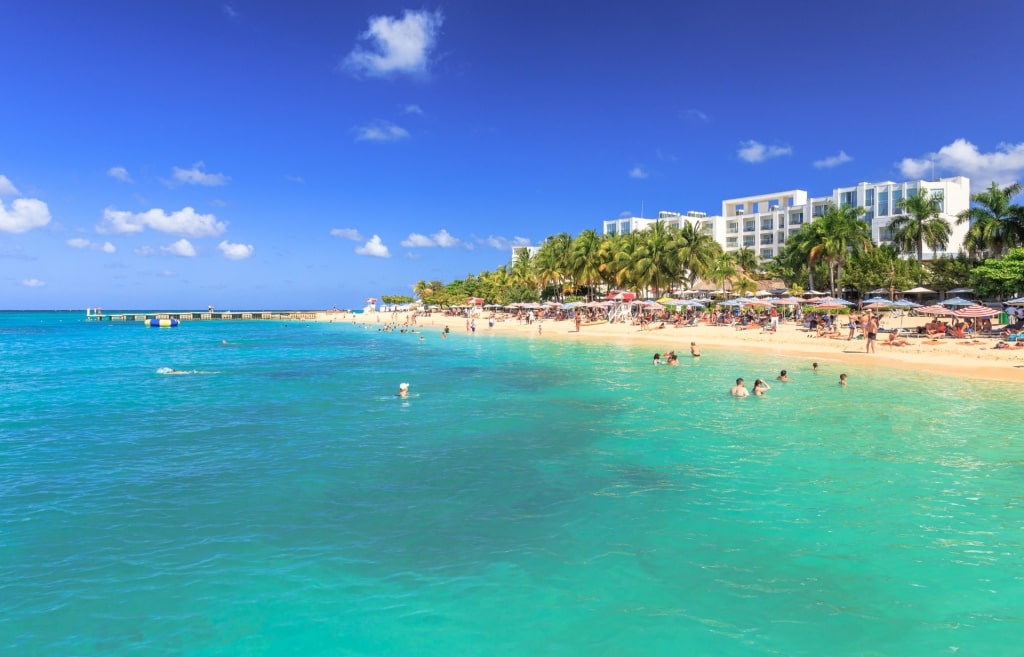
Doctor’s Cave Beach
Or head for Doctor’s Cave Bathing Club at Montego Bay, also known as Doctor’s Cave Beach, a long stretch of sugar-soft sand where you can rent chairs and umbrellas and take your pick of shoreside eateries. Snorkelers might spot stingrays, blue tangs, grunts, and butterflyfish in the clear, blue water.
A day at Doctor’s Cave Beach puts you at the southern end of Jamaica’s Hip Strip, a long stretch of Gloucester Avenue lined with shops, eateries, and restaurants. For lunch, try the jerk chicken, curried shrimp, and oxtail at the strip’s Pelican Grill, owned and operated by the same family for more than 50 years.
Read: Best Caribbean Islands for Couples
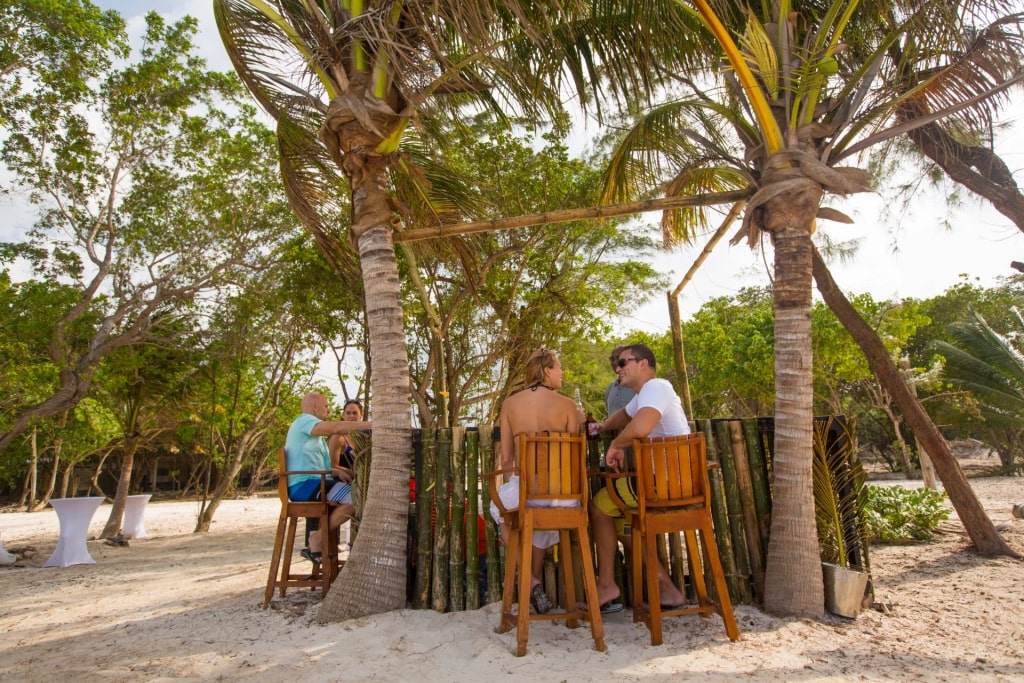
Blue Waters Beach Club
Ready to explore Jamaica? Find your island fun by browsing premium cruises on our website.
